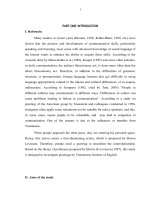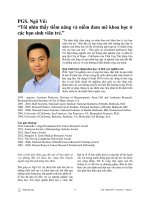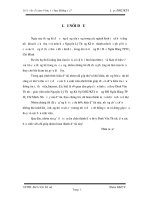8 beam deflection 2015 bach khoa
Bạn đang xem bản rút gọn của tài liệu. Xem và tải ngay bản đầy đủ của tài liệu tại đây (1.64 MB, 22 trang )
CHAPTER 8: BEAM DEFLECTION
8.1 Deflection of a beam under transverse loading
8.2 Equation of the elastic curve
8.3 Direct determination of the elastic curve from the loading
8.4 Statically indeterminate beams
8.5 Examples
8.6 Statically indeterminate beams
8.1 DEFLECTION OF A BEAM UNDER TRANSVERSE
LOADING
• Relationship between bending moment and
curvature for pure bending remains valid for
general transverse loadings.
1
M ( x)
EI
• Cantilever beam subjected to concentrated
load at the free end,
1
Px
EI
• Curvature varies linearly with x
1
• At the free end A, ρ 0,
A
1
• At the support B,
B
ρA
0, B
EI
PL
8.1 DEFLECTION OF A BEAM UNDER TRANSVERSE
LOADING
• Overhanging beam
• Reactions at A and C
• Bending moment diagram
• Curvature is zero at points where the bending
moment is zero, i.e., at each end and at E.
1
M ( x)
EI
• Beam is concave upwards where the bending
moment is positive and concave downwards
where it is negative.
• Maximum curvature occurs where the moment
magnitude is a maximum.
• An equation for the beam shape or elastic curve
is required to determine maximum deflection
and slope.
8.2 EQUATION OF THE ELASTIC CURVE
• From elementary calculus, simplified for beam
parameters,
d2y
1
dx
2
2 3 2
dy
1
dx
d2y
dx 2
• Substituting and integrating,
EI
1
EI
d2y
dx
2
M x
x
dy
EI EI
M x dx C1
dx
0
x
x
0
0
EI y dx M x dx C1x C2
8.2 EQUATION OF THE ELASTIC CURVE
• Constants are determined from boundary
conditions
x
x
0
0
EI y dx M x dx C1x C2
• Three cases for statically determinant beams,
– Simply supported beam
y A 0,
yB 0
– Overhanging beam
y A 0,
yB 0
– Cantilever beam
y A 0, A 0
• More complicated loadings require multiple
integrals and application of requirement for
continuity of displacement and slope.
8.3 DIRECT DETERMINATION OF THE ELASTIC CURVE
FROM THE LOAD DISTRIBUTION
• For a beam subjected to a distributed load,
d 2M
dM
V x
dx
dV
w x
2
dx
dx
• Equation for beam displacement becomes
d 2M
dx
2
EI
d4y
dx
4
w x
• Integrating four times yields
EI y x dx dx dx w x dx
16 C1x3 12 C2 x 2 C3 x C4
• Constants are determined from boundary
conditions.
8.4 STATICALLY INDETERMINATE BEAMS
• Consider beam with fixed support at A and roller
support at B.
• From free-body diagram, note that there are four
unknown reaction components.
• Conditions for static equilibrium yield
Fx 0 Fy 0 M A 0
The beam is statically indeterminate.
• Also have the beam deflection equation,
x
x
0
0
EI y dx M x dx C1x C2
which introduces two unknowns but provides
three additional equations from the boundary
conditions:
At x 0, 0 y 0
At x L, y 0
8.5 EXAMPLES
EXAMPLE 9.01
SOLUTION:
•Develop an expression for M(x) and
derive differential equation for elastic
curve.
W 14 68
I 723 in 4
E 29 106 psi
P 50 kips
L 15 ft
a 4 ft
•Integrate differential equation twice
and apply boundary conditions to
obtain elastic curve.
For portion AB of the overhanging beam,
•Locate point of zero slope or point of
(a) derive the equation for the elastic curve, maximum deflection.
(b) determine the maximum deflection,
•Evaluate corresponding maximum
(c) evaluate ymax.
deflection.
8.5 EXAMPLES
EXAMPLE 9.01
SOLUTION:
•Develop an expression for M(x) and derive
differential equation for elastic curve.
-Reactions:
RA
Pa
a
RB P1
L
L
-From the free-body diagram for section AD,
M P
a
x
L
0 x L
-The differential equation for the elastic
curve,
EI
d2y
a
P
x
2
L
dx
8.5 EXAMPLES
EXAMPLE 9.01
•Locate point of zero slope or point of
maximum deflection.
2
dy
PaL
xm
0
1 3
dx
6 EI
L
PaL2 x x
y
6 EI L L
3
xm
L
0.577 L
3
•Evaluate corresponding maximum
deflection.
PaL2
ymax
0.577 0.577 3
6 EI
PaL2
ymax 0.0642
6 EI
ymax
50 kips 48 in 180 in 2
0.0642
6 29 106 psi 723 in 4
ymax 0.238 in
8.5 EXAMPLES
EXAMPLE 9.02
SOLUTION:
•Develop the differential equation for the
elastic curve (will be functionally
dependent on the reaction at A).
For the uniform beam, determine the
reaction at A, derive the equation for
the elastic curve, and determine the
slope at A. (Note that the beam is
statically indeterminate to the first
degree)
•Integrate twice and apply boundary
conditions to solve for reaction at A and
to obtain the elastic curve.
•Evaluate the slope at A.
8.5 EXAMPLES
EXAMPLE 9.02
•Consider moment acting at section D,
MD 0
1 w0 x 2 x
RA x
M 0
2 L 3
w0 x3
M RA x
6L
•The differential equation for the elastic curve,
d2y
w0 x3
EI 2 M R A x
6L
dx
8.5 EXAMPLES
EXAMPLE 9.02
•Integrate twice
4
dy
1
2 w0 x
EI
EI RA x
C1
dx
2
24 L
5
1
3 w0 x
EI y RA x
C1x C2
6
120 L
2
EI
d y
w0 x
M
R
x
A
6L
dx 2
3
•Apply boundary conditions:
at x 0, y 0 : C2 0
3
1
2 w0 L
at x L, 0 :
RA L
C1 0
2
24
4
1
3 w0 L
at x L, y 0 :
RA L
C1L C2 0
6
120
•Solve for reaction at A
1
1
RA L3 w0 L4 0
3
30
RA
1
w0 L
10
8.5 EXAMPLES
EXAMPLE 9.02
•Substitute for C1, C2, and RA in the elastic
curve equation,
5
1 1
3 w0 x 1
EI y w0 L x
w0 L3 x
6 10
120 L 120
y
w0
x5 2 L2 x3 L4 x
120 EIL
•Differentiate once to find the slope,
dy
w0
5 x 4 6 L2 x 2 L4
dx 120 EIL
at x = 0,
w0 L3
A
120 EI
8.6 METHOD OF SUPERPOSITION
Principle of Superposition:
•Deformations of beams subjected to
combinations of loadings may be
obtained as the linear combination of
the deformations from the individual
loadings
•Procedure is facilitated by tables of
solutions for common types of
loadings and supports.
8.6 METHOD OF SUPERPOSITION
EXAMPLE 9.03
For the beam and loading shown,
determine the slope and deflection at
point B.
SOLUTION:
Superpose the deformations due to Loading I and Loading II as shown.
8.6 METHOD OF SUPERPOSITION
EXAMPLE 9.03
Loading I
wL3
B I
6 EI
wL4
yB I
8EI
Loading II
wL3
C II
48 EI
wL4
yC II
128 EI
In beam segment CB, the bending moment is
zero and the elastic curve is a straight line.
wL3
B II C II
48 EI
wL4
wL3 L 7 wL4
yB II
128 EI 48 EI 2 384 EI
8.6 METHOD OF SUPERPOSITION
EXAMPLE 9.03
Combine the two solutions,
wL3 wL3
B B I B II
6 EI 48 EI
7 wL3
B
48 EI
wL4 7 wL4
yB yB I yB II
8EI 384 EI
41wL4
yB
384 EI
8.6 METHOD OF SUPERPOSITION
APPLICATION OF SUPERPOSITION TO STATICALLY
INDETERMINATE BEAMS
•Method of superposition may be applied •Determine the beam deformation
to determine the reactions at the supports without the redundant support.
of statically indeterminate beams.
•Treat the redundant reaction as an
unknown load which, together with the
•Designate one of the reactions as
other loads, must produce deformations
redundant and eliminate or modify the
compatible with the original supports.
support.
8.6 METHOD OF SUPERPOSITION
EXAMPLE 9.04
For the uniform beam and loading shown,
determine the reaction at each support and
the slope at end A.
SOLUTION:
•Release the “redundant” support at B, and find deformation.
•Apply reaction at B as an unknown load to force zero displacement at B.
8.6 METHOD OF SUPERPOSITION
EXAMPLE 9.04
•Distributed Loading:
yB w w
24 EI
3
2 4
2
3 2
L 2 L L L L
3
3
3
wL4
0.01132
EI
•Redundant Reaction Loading:
2
2
RB 2 L
RB L3
yB R
L 0.01646
3EIL 3 3
EI
•For compatibility with original supports, yB = 0
wL4
RB L3
0 yB w yB R 0.01132
0.01646
EI
EI
RB 0.688 wL
•From statics,
R A 0.271wL
RC 0.0413 wL
8.6 METHOD OF SUPERPOSITION
EXAMPLE 9.04
Slope at end A,
wL3
wL3
A w
0.04167
24 EI
EI
0.0688 wL L 2 L
A R
L
6 EIL 3
3
2
wL3
0.03398
EI
wL3
wL3
A A w A R 0.04167
0.03398
EI
EI
wL3
A 0.00769
EI









